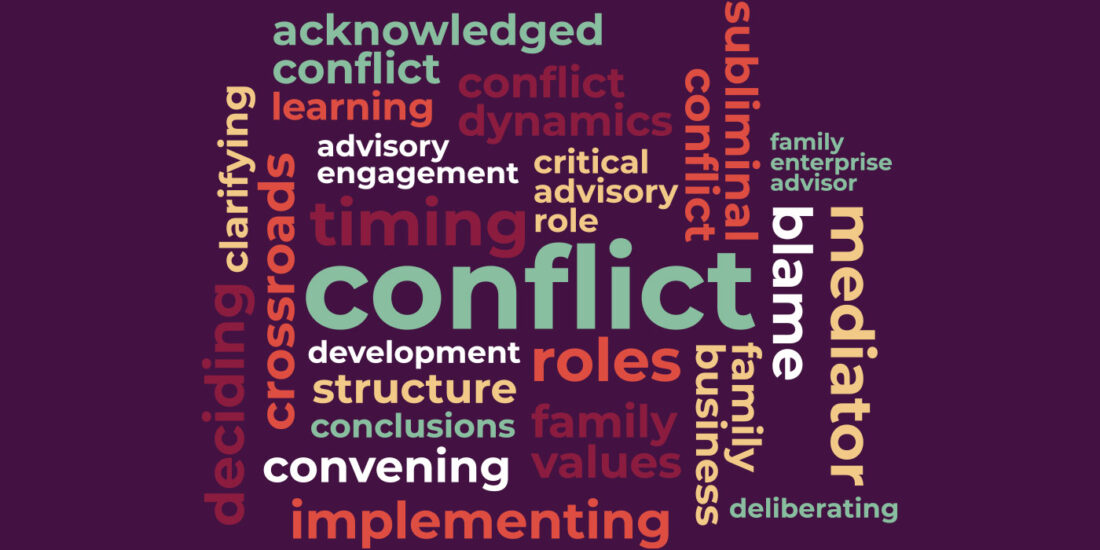
View this edition in our enhanced digital edition format with supporting visual insight and information.
Thank you to this week’s contributor, Ricardo Mejia, for his article exploring how implementing short-term strategic projects can further the alignment of owners and help manage conflict within the family enterprise.
Conflict is undeniably one of the major challenges that advisors face when working with entrepreneurial families. Advisors study the causes and history of the conflict and then utilize the many tools that the fields of psychology and other social sciences have developed to help manage the negative effects of the conflict. I stress the word “manage,” because most of the time these deep-seated conflicts never fully disappear.
In my experience, conflict in family enterprises can often be traced back to a lack of strategic alignment among the stakeholders. Accordingly, I have learned that by helping the family develop shared business values, mission, vision, and strategy for the next three to five years, advisors can often succeed in aligning family members’ strategy—even when the participants may be in conflict on other matters. In other words, developing a well-defined and shared corporate strategy is an important aspect of managing conflict—even when the family owners have divergent views on the longer-term future of the business. An effective corporate strategy can provide a clear path to the implementation of important projects that can transform the business.
This is what high-performing companies do, whether they or not they are family-owned.
For example, when the Nike, Inc., position of corporate strategy and development manager for Europe, Middle East and Africa was vacant in 2016, the functions of the position were summarized in a strategic planning, market, and competitor analysis. Nike wanted a professional capable both of understanding future challenges and opportunities and of creating and implementing new proposals. Consequently, the job profile required that candidates have the ability to implement cross-cutting and strategic projects. This was an important and radical change in culture: strategy had to be translated into projects.
In Colombia, Alfredo Carvajal, third-generation leader of the Carvajal family, once told me that between 2002 and 2008, when he was the company CEO, his top strategic priority was to convert the family business into a more modern company through restructuring the corporate governance. His efforts were successful, and today Carvajal’s governance structure has become a model in Latin America.
More than 70% of strategies fail in their purpose of creating value,1 because these strategies are not easy to communicate and may not have adequate metrics. In my experience, when the strategy behind projects is effectively communicated, with adequate leadership and budgets as well as realistic timelines for execution, the chances of successful implementation markedly improve.
One of the main functions of the board of directors is to help prioritize the initiatives presented by the management team—such a discussion should result in narrowing the focus of management to only a few projects. For many management teams, it can be just as bad to not have any ambitious and transformational projects as it is to have too many. Without a clear exercise of priorities, executives could end up in a struggle for the same resources, unable to meet the desired outcomes.
The challenge for companies today goes beyond operational excellence. This attribute is certainly a must-have, but is it enough? The board and management must periodically analyze whether there is an initiative, a new market, a new business, a family of new products, or a new distribution channel to venture into and prepare the company for changes and challenges that it will, no doubt, face in the future. Opening an operation in another region or country is a good example. Such a project requires a multidisciplinary group from marketing, operations, logistics, human resources, legal, etc., to propose to the board of directors whether to acquire an operation or start from scratch. While doing this analysis, they will be forced to update processes, seek new information, work under pressure, and leave their comfort zone.
According to Antonio Nieto-Perez, author of The Project Revolution, Thinkers50 award winner, and world expert in project strategy, by 2025 business executives will spend at least 60% of their time prioritizing, selecting, and implementing projects.2 They will end up working as project managers!
Most family enterprise advisors recognize the importance of developing a compelling corporate strategy for their clients—a strategy that identifies at least one ambitious project and prioritizes broadening the company’s perspectives. However, developing an inspiring short-term strategy and related projects for family enterprise clients can have additional benefits beyond increasing the company’s profits. When the family ownership group can come together to develop a shared strategy for the business, it may actually help to align the owners and to manage the impacts of conflict between the family members.
If your client does not have an ambitious strategy and transformative project, it’s time to work with the family to find one, and in the process focus on aligning the family members behind it.
References
1“70% of Your Strategies Fail.” Behavioural Strategy Group. https://behaviouralstrategygroup.com/2020/10/13/70-of-all-strategic-initiatives-fail/. Published October 13, 2020.
2Nieto-Rodriguez, A. (2020, March 26). The Project Economy – Why Projects Are The Future. https://www.scribd.com/document/461028896/The-Project-Economy-Why-Projects-Are-the-Future
About the Contributor

Ricardo Mejia, CFBA, CFWA, is a former FFI board member. After a long career as manager in public and family-owned companies, he developed extensive experience in corporate governance, strategy, and KPI management. He has been professor in the management programs at Universidad de Los Andes and Universidad EAFIT, is a contributor to several Colombian newspapers, and is frequently invited as lecturer in national forums. Ricardo can be reached at ricardom@sdj.com.co.

View this edition in our enhanced digital edition format with supporting visual insight and information.





